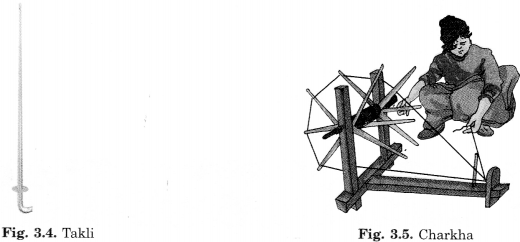NCERT Solutions for Class-6 Science Chapter-3 Fibre to Fabric
NCERT TEXTBOOK EXERCISES
nylon, wool, cotton, silk, polyester, jute.
Answer:
Natural fibres:
1. Wool
2. Cotton
3. Silk
4. Jute
Synthetic fibres:
1. Nylon
2. polyester
1. Yarn is made from fibres.
2. Spinning is the process of making fibres.
3. Jute is the outer covering of coconut.
4. The process of removing seeds from cotton is called ginning.
5. Weaving yarn makes a piece of fabric.
6. Silk fibre is obtained from the stem of a plant.
7. Polyester is a natural fibre.
Answer:
1. True
2. False
3. False
4. True
5. True
6. False
7. False
Fill in the blanks :
(a) Plant fibres are obtained from ________ and ________.
(b) Animal fibres are ________ and ________.
Answer:
(a) Cotton and Jute
(b) Silk and Wool
Question 4. From which parts of the plant cotton and jute are obtained?
Answer :
(i) Cotton - cotton bolls (fruits).
(ii) Jute - stem.
Question 5. Name two items that are made from coconut fibre.
Answer: Ropes and Coir in mattresses are made from coconut fibres.
Question 6. Explain the process of making yarn from fibre.
Answer: The process of making yarn from fibres is called spinning. In this process, fibres from a mass of cotton wool are drawn out and twisted. This brings the fibres together to form yarn. A simple device used for spinning is a hand spindle called takli.
Another hand-operated device used for spinning is charkha. Spinning of yarn on a large scale is done with the help of spinning machines.

0 comment
Post a Comment